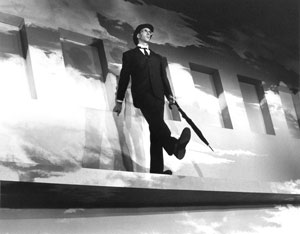Canadian Theatre Encyclopedia
7 Stories

Set Design: Ken MacDonald
Black comedy by Morris Panych, premiered at the Arts Club Theatre, Vancouver British Columbia in May, 1989, directed by Panych, with set design by Ken MacDonald. The play is set on the seventh storey ledge of an apartment building, in front of several windows. The protagonist, simply named “Man,” stands on the ledge, contemplating a jump, but he is constantly delayed by interruptions from the individuals in the apartments. Charlotte and Rodney play violent games which heighten their sense of being alive by bringing them closer to death. Leonard, a paranoid psychiatrist, refuses to acknowledge any definable reality by continually shifting his perspective and interpretation. Marshall denies his own reality, and adopts a persona for personal and financial gain. Rachel, a religious fanatic, constructs a bogus faith and contrives catastrophes to incite others to subscribe, parodying God’s trials of Job. Joan and Michael “expose the utter pointlessness of dressing for an existence that is all pretence. For them, human consensus is simply a reduction of life to ‘beige,’ and the central question is ‘which beige?’” (Gilbert CTR 10). All are attempting to escape their limitations, to explore other ways of being and perceiving.
An old woman, Lillian, functions as a kind of seer in the play, Her advice to the Man that he must fly – must rise above his limited and negative point of view -- is an indicator that the imagination can create for itself a freer environment, a larger space. For Lillian, her enclosed space, a small room which she has not left for fifty years, can be very large. Freedom is a state of mind.
7 Stories is a highly metatheatrical play in that it draws attention to its form and conventions: the structure functions as a metaphor. The characters point to their own role-playing as a way to create a reality for themselves which has some significance. They state and question the themes of the play; and at the end, an audience is created which observes the Man’s miraculous flight which functions as a climax, before it (and we) are dismissed from the scene by the police. Theatre, then, becomes a way of imagining life, and the play points many times to the ways in which “all the world’s a stage, and the men and women merely players” (to quote Jaques in Shakespeare’s As You Like It). The ledge on which the Man stands is a form of stage, on which he thinks he is playing out his last scene, unobserved, but where he is in fact very visible.
Marshall’s view of theatre as life is more cynical: he points to the absurdity of “squeezing a whole existence into a measly evening’s entertainment on the stage.” Panych in effect functions as his own critic – undercutting any predilection to pretentious philosophizing in the play. He further satirizes attempts to find “meaning” in the events of the play by providing a variety of interpretation by the four characters who witness the Man flying. According to critic Reid Gilbert:
”These speeches are strongly metadramatic examples of . . . ‘self-reference,’ where the play directly calls attention to itself as a play. These four characters exist within the main play as neighbours, exist with a separate play-within-a-play, and simultaneously pull the audience out of the illusion both by becoming its representatives in asking questions and by satirizing the whole play in mock literary analysis” (THC 143).
But even though the enterprise may appear absurd, it may also create the possibility for other ways of seeing, a ledge from which to view the world.
Each character has a story to tell the Man, who functions first as an audience, and then as the protagonist, when he finally tells his own story in a lengthy monologue near the end. Lillian’s absurd story of how the despairing and disillusioned Frenchman (an allusion to the existentialism of Sartre, a French philosopher) makes nonsense out of any attempt to find a philosophy by which to live. It prompts the Man to recount his own moment of crisis, when he lost his faith in the structure that provided his life with some meaning, or at least direction. Although there are continual references to, and examples of miscommunication and misunderstanding in the play, the act of storytelling, of creating an imaginative construct in an effort to make sense of life, is shown to provide a way of coming to terms with chaos. As the Man recognizes after hearing Lillian’s story, he has forgotten his own . . . “and flew on the wings of someone else’s.” Art provides a necessary perspective from which to see the world, as Charlotte points out, although it may be only a momentary diversion. Panych resists providing definitive solutions to the metaphysical conundrums in his plays, only possible responses.
The protagonist of 7 Stories is in effect an “everyman,” struggling to find meaning in his life, to break free of his limitations and his restricted sense of self. The one choice he believes he is free to make is whether to live or to die – Hamlet’s decision whether “to be or not to be.” He appears as a Chaplinesque figure dressed in a suit and bowler, and carrying an umbrella. Initially he says little, and provides a convenient audience for the self-centred preoccupations of others, but he gradually engages in dialogue and debate, until his final fully articulate monologue. In this character Panych combines the comic fool and the tragic hero.
Sources: Reid Gilbert. “Metadramatic Design in the Stage Work of Morris Panych and Ken MacDonald,” Theatre History in Canada 11 (Fall 1990): 134-47; Reid Gilbert. “The Theatrical Stories of Morris Panych,” Canadian Theatre Review 67 (Summer 1991): 5-11.
Commentary by Anne Nothof, Athabasca University
Last updated 2012-02-05

